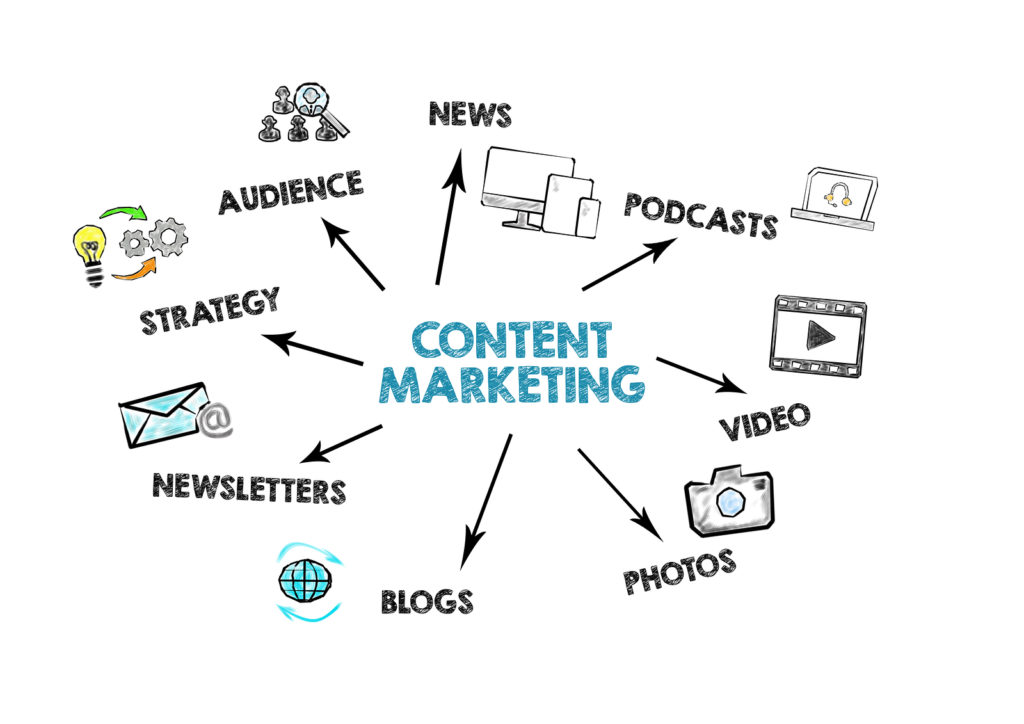The Role of Content Marketing in SEO
Content marketing and SEO go hand-in-hand to drive traffic, engagement, and conversions for your website. By creating high-quality, relevant content, you can improve your search engine rankings and attract more visitors. In this blog, we’ll explore how content marketing supports SEO and provide strategies for creating SEO-friendly content.
Section 1: Understanding Content Marketing
Definition of Content Marketing: Content marketing involves creating and distributing valuable, relevant, and consistent content to attract and engage a clearly defined audience. Unlike traditional advertising, content marketing focuses on providing useful information that meets the needs and interests of potential customers.
Types of Content Marketing:
- Blog Posts: Regularly updated articles on your website that provide insights, tips, and information related to your industry.
- Articles: In-depth pieces that cover specific topics or issues in detail.
- Infographics: Visual representations of data and information that are easy to understand and share.
- Videos: Engaging visual content that can explain complex topics, showcase products, or tell stories.
- Podcasts: Audio content that allows listeners to learn and engage while multitasking.
- Social Media Content: Posts, images, and videos shared on social media platforms to engage with your audience.
Goals of Content Marketing:
- Building Brand Awareness: Creating content that introduces your brand to a wider audience.
- Engaging with the Audience: Providing valuable information that keeps your audience interested and engaged.
- Driving Traffic: Attracting visitors to your website through high-quality content.
- Generating Leads: Encouraging visitors to take action, such as signing up for a newsletter or requesting a consultation.
Section 2: Creating SEO-Friendly Content
Tips to create SEO-friendly content
Keyword Research and Integration:
- Finding Relevant Keywords: Use tools like Google Keyword Planner, Ahrefs, and SEMrush to identify keywords that your target audience is searching for. Focus on keywords with high search volume and low competition.
- Integrating Keywords Naturally: Incorporate keywords into your content in a way that feels natural and doesn’t disrupt the flow of the text. Avoid keyword stuffing, which can harm your SEO efforts.
Writing High-Quality Content:
- Content Relevance: Ensure your content addresses the needs and interests of your target audience. Provide valuable information that solves problems or answers questions.
- Engagement and Readability: Write in a clear, engaging style that is easy to read. Use headings, subheadings, bullet points, and short paragraphs to break up the text and improve readability.
- Content Length and Depth: Longer, more in-depth content tends to perform better in search rankings. Aim for comprehensive articles that cover topics thoroughly, while still being engaging and easy to read.
Content Optimization:
- Meta Titles and Descriptions: Write compelling meta titles and descriptions that include your target keywords. These elements help search engines understand the content of your pages and encourage users to click on your links in search results.
- Header Tags (H1, H2, H3): Use header tags to structure your content and make it easier for search engines to understand. Include keywords in your headers to signal the relevance of your content.
- Internal and External Links: Link to other relevant pages on your website to keep users engaged and improve site navigation. Include external links to authoritative sources to add credibility to your content.
Section 3: Content Distribution and Promotion
Let’s dive deep into Content Distribution and Promotion
Channels for Distributing Content:
- Social Media: Share your content on social media platforms like Facebook, Twitter, LinkedIn, and Instagram. Use engaging visuals and compelling captions to attract attention.
- Email Marketing: Send your content to your email subscribers through newsletters or dedicated email campaigns. Include links to your latest blog posts, articles, or videos.
- Guest Blogging: Write guest posts for other reputable websites in your industry. This helps you reach a broader audience and earn backlinks to your site.
- Content Syndication: Republishing your content on other platforms to reach a new audience. Ensure that syndicated content includes canonical tags to avoid duplicate content issues.
Strategies for Promoting Content:
- Social Media Advertising: Use paid ads to promote your content on social media platforms. Target specific demographics to reach your ideal audience.
- Influencer Collaborations: Partner with influencers in your industry to share your content with their followers. Influencers can help amplify your reach and attract new visitors.
- Content Sharing Communities: Participate in online communities and forums related to your industry. Share your content and engage with other members to build relationships and drive traffic to your site.
Section 4: Measuring Content Marketing Success

Key Metrics to Track:
- Organic Traffic: Monitor the number of visitors coming to your website from search engines. Use tools like Google Analytics to track organic traffic over time and identify trends.
- Engagement Metrics: Assess how users interact with your content by tracking metrics such as:
- Bounce Rate: The percentage of visitors who leave your site after viewing only one page. A high bounce rate may indicate that your content is not engaging or relevant to visitors.
- Average Session Duration: The average amount of time visitors spend on your site. Longer sessions typically indicate more engaging content.
- Pages Per Session: The average number of pages viewed during a session. Higher pages per session suggest that visitors are finding your content useful and exploring your site further.
- Conversion Rates: Measure how well your content is driving conversions, such as newsletter sign-ups, form submissions, or product purchases. Set up goals in Google Analytics to track these conversions.
- Social Shares: Track how often your content is shared on social media platforms. Social shares can increase your content’s reach and drive more traffic to your site.
Tools for Measuring Content Performance:
- Google Analytics: Provides comprehensive insights into your website traffic, user behaviour, and conversion rates. Use it to track key metrics and evaluate the effectiveness of your content marketing efforts.
- SEMrush/Ahrefs: Use these tools to track keyword rankings, backlink profiles, and overall SEO performance. They can help you understand how your content is performing in search results.
- Social Media Analytics: Platforms like Facebook Insights, Twitter Analytics, and LinkedIn Analytics provide data on how your content is performing on social media. Use these insights to refine your social media strategy.
Section 5: Best Practices for Integrating UGC into Your Website
Let’s have a look at Best Practices for Integrating UGC into Your Website
Displaying Reviews and Testimonials on Key Pages:
- Home Page: Highlight a few glowing reviews to immediately build trust with new visitors.
- Product/Service Pages: Include reviews and testimonials related to specific products or services on their respective pages to help persuade potential customers.
Use UGC in Blog Posts and Case Studies:
- Customer Stories: Write blog posts that feature detailed stories or interviews with satisfied customers.
- Case Studies: Create case studies that showcase how your product or service helped a particular customer or solved a problem.
Feature Customer Photos and Videos:
- UGC Gallery: Create a dedicated gallery page where visitors can see a collection of customer photos and videos.
- Product Pages: Show customer photos of products in use, which can provide social proof and help potential buyers see real-world applications.
Create a Dedicated UGC Section:
- Testimonials Page: Have a page dedicated to customer testimonials, showcasing a variety of feedback.
- Community Page: Feature stories, photos, and videos from your community of customers, making your website feel more like a community hub.
By integrating UGC into your website, you not only enhance your SEO but also create a more engaging and trustworthy experience for your visitors.
Section 6: Continuous Improvement
Continuous Improvement in content marketing
Regular Content Audits:
- Purpose of Content Audits: Conduct regular audits of your content to assess its performance, relevance, and SEO effectiveness. Identify which pieces of content are driving traffic and conversions and which ones need improvement.
- Steps for Conducting a Content Audit:
- Inventory Your Content: List all the content on your website, including blog posts, articles, videos, and infographics.
- Evaluate Performance: Use tools like Google Analytics to assess the performance of each piece of content. Look at metrics such as traffic, engagement, and conversions.
- Identify Gaps and Opportunities: Identify content gaps and opportunities for new content based on keyword research and audience needs.
- Update and Optimise: Refresh outdated content with new information, optimise it for SEO, and improve its overall quality.
Staying Updated with SEO Trends:
- Follow Industry News: Keep up with the latest developments in SEO and content marketing by following industry blogs, news sites, and social media channels.
- Continuous Learning: Attend webinars, conferences, and online courses to stay updated on the latest SEO and content marketing strategies.
- Experiment and Test: Regularly test new content ideas and SEO techniques to see what works best for your audience and industry.
Feedback and Adaptation:
- Gather Feedback: Collect feedback from your audience through surveys, comments, and social media interactions. Use this feedback to improve your content strategy.
- Adapt to Changes: Be prepared to adapt your content strategy based on changes in search engine algorithms, audience preferences, and industry trends.
Semrank provides tailored SEO services to help businesses in Milton Keynes enhance their online presence and attract more local customers.




